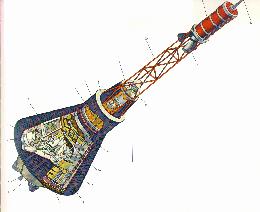
Cutaway view of the Mercury capsule
Image scanned from Quest for Space by C. Bongiorno

The spacecraft itself consisted of a conical crew compartment with a set of rocket engines strapped to the back and a cylindrical nosecone set into the front. The rockets were used for the deorbit burn once this ship was ready for reentry. After slowing the craft down, the rockets would fall off. The bottom of the crew compartment was covered with ablative armor, a technology which is still in use today. Ablative armor works by evaporating as it gets hot, taking the heat energy away with it, much in the same way that perspiration works for many humanoid life forms. Two different launch vehicles were used during the Mercury program, Redstone and Atlas. Redstone was only used for two manned, suborbital missions. The much more powerful Atlas ICBM was used for the remainder of the 4 missions.
The following is a list of the seven Mercury astronauts and their vehicle names. Donald Slayton was not able to fly for medical reasons. All capsule designations had "7" after their names, signifying the 7 Mercury astronauts.
Navy Lieutenant Commander Alan Shepard - Freedom 7
Air Force Captain Virgil I. "Gus" Grissom - Liberty Bell 7
Marine Lt. Col. John Glenn - Friendship 7
Navy Lt. Malcolm Scott Carpenter - Aurora 7
Navy Lt. Cmdr. Walter "Wally" Schirra - Sigma 7
Air Force Captain L. Gordon Cooper - Faith 7
Specifications:
Length: 3.4 m
Mass: 1.5 tons
Crew: 1
Propulsion: Chemical
